.avif)
.avif)
Referral incentives are one of the most cost-effective ways to acquire and retain high-value customers. They transform your happiest buyers into active advocates, driving growth through trusted recommendations.
Many SMBs and D2C brands overlook this channel, instead relying on paid ads that become expensive and less effective over time. This creates missed opportunities for sustainable, low-CAC growth.
The solution is a well-structured referral program with clear, motivating rewards. Incentives like milestone bonuses after five referrals encourage repeat sharing and build lasting loyalty.
This guide breaks down proven models, creative ideas, and step-by-step playbooks to help you design referral incentives that scale.
Key Takeaways
- Referral incentives lower CAC and boost retention by turning loyal customers into active brand advocates.
- Tiered and two-sided reward models drive sustained engagement through fairness, progress, and motivation.
- Creative incentives, such as early access, upgrades, and charity tie-ins, foster deeper emotional loyalty than discounts alone.
- Seamless design, automation, and visibility keep referral programs efficient, fraud-free, and easy to scale.
- Continuous tracking, testing, and storytelling transform referral programs into self-sustaining growth engines.
Referral Programs 101: Mechanics, Models, and Why They Work
A referral program is a structured way to turn satisfied customers into growth partners. It rewards people for sharing your product or service with their friends, colleagues, or communities. Instead of spending heavily on ads, brands use referral incentives to activate trust, the most reliable driver of conversions.
How Referral Programs Work
At their core, referral programs follow a simple three-step process:
- Share: A customer receives a unique referral link or code.
- Act: Their friend or peer uses that link to make a purchase or sign up.
- Reward: The system verifies the action and delivers the promised incentive.
Behind this simple flow is an intentional design. Effective programs are easy to join, transparent about rewards, and automated to track every referral accurately.
The Psychology Behind Referrals
Referral marketing works because it taps into three powerful behavioral principles:
- Reciprocity: People are more likely to share when they receive value in return.
- Social Proof: Seeing a product endorsed by a trusted person makes it feel safer to buy.
- Exclusivity: Rewards, early access, or insider perks make people feel part of something special.
These psychological triggers create motivation and trust, two things that traditional ads struggle to replicate.

Why SMBs and D2C Brands Use Referral Programs
Referral programs are not just for large enterprises. For small and medium-sized businesses, they are one of the most affordable ways to grow.
They offer numerous benefits, such as:
- Lower customer acquisition cost (CAC): Organic sharing replaces costly ad spend.
- Higher conversion rates: Referred customers arrive pre-qualified and confident.
- Better retention and community-building: When customers refer others, they feel more invested in the brand.
Referral vs Affiliate Programs
Referral programs are customer-driven, built around genuine advocacy and rewards that strengthen loyalty. Affiliate programs, in contrast, are influencer-driven, focusing on partnerships and commissions for exposure. Both can work together, but referrals offer a more authentic and sustainable growth model.
When executed well, referral programs become a scalable engine of trust, growth, and retention. The system works best when paired with smart, motivating rewards that make referrals feel rewarding for both sides.
Also Read: Effective Strategies for Referral Incentives
6 Proven Referral Incentive Strategies That Drive Growth

Referral incentives are most effective when they offer more than just simple discounts. The goal is to motivate consistent sharing, reward meaningful milestones, and strengthen the customer’s relationship with your brand.
1. Tiered Incentives That Unlock Bigger Rewards
Flat rewards may spark short-term interest, but they rarely sustain engagement. Tiered incentives create momentum by giving customers a reason to keep referring, and every milestone they reach unlocks something better.
The psychology is simple: progress feels rewarding. When customers can see their achievements grow, they stay motivated to continue.
Here’s a clear, incremental example:
- 1 referral: Small reward, such as a 10% discount or free shipping.
- 3 referrals: Free product sample, store credit, or early access to a sale.
- 5 referrals: Milestone bonus, a premium gift or cash reward (supports the idea of getting a bonus for every five customer referrals).
- 10 referrals: VIP treatment, including exclusive membership, special perks, or dedicated account support.
This setup turns referrals into a game-like experience rather than a simple transaction. Customers stay driven when they know they’re getting a bonus for every five customer referrals, transforming the process into a journey of ongoing rewards rather than one-time incentives.
When crafting incremental referrals, remember the following:
Align Rewards with Customer Psychology
Each tier should feel like a true step up from the last. The jump from a slight discount to a tangible five-referral milestone reward should feel exciting and earned. That sense of progress keeps customers motivated long after their first share.
Make Progress Visible
A strong user experience brings your referral system to life. Use tools that make achievement tangible:
- Visual progress bars to track referrals
- Milestone badges to celebrate success
- Automated notifications to remind users when they’re close to their next reward
When customers can see progress, they’re more likely to stay engaged.
Pro Tip: Combine visual design with emotional triggers. Recognition matters as much as rewards. A congratulatory message or spotlight on top referrers can build stronger loyalty than another coupon.
2. Two-Sided Rewards for Maximum Engagement
A two-sided referral model rewards both the referrer and the referee. It creates a sense of fairness and mutual benefit that drives participation. When both parties win, the program feels collaborative rather than promotional.
For example:
- “Give $10, Get $10” for each successful referral.
- Enjoy a free month of service, available to both existing and new users.
- Waived onboarding fees for new clients and account credits for referrers.
This approach works exceptionally well for SaaS, D2C, and marketplace businesses where trust is essential. Referred customers join with confidence, knowing their peers already use and value the product.
Messaging plays a crucial role here. Use language that highlights shared success: “Invite your friends and both of you win.” When framed as a partnership, referral participation rates increase significantly.
Two-sided incentives balance reward and relationship. They make your program inclusive, transparent, and naturally appealing to new audiences.
3. Creative Non-Cash Incentives That Build Loyalty
Not every reward needs to be a discount or cash payout. In fact, non-cash incentives often build deeper loyalty because they connect emotionally with your brand and reflect your values.
Here are four types of creative, high-impact non-cash rewards:
3.1 Upgrades and Service Add-ons
If you offer a SaaS product, consider feature unlocks or access to premium tools. Service-based businesses can provide free consultations, extended warranties, or priority support. These rewards enhance perceived value while costing less than cash equivalents.
3.2 Early Access to New Products or Features
Reward top referrers with early access to new launches, beta programs, or limited-edition items. This not only drives referrals but also makes participants feel like insiders. For consumer brands, early access builds anticipation and creates organic buzz before launch day.
3.3 Cause-Based or Charitable Rewards
Today’s customers value purpose-driven brands. Tie each referral to a positive impact, such as donating to a social or environmental cause after every five referrals. This approach builds emotional loyalty and aligns referrals with customers’ personal values.
3.4 Mystery or Surprise Gifts
Surprise incentives add curiosity and excitement. A “mystery box after five referrals” encourages consistent engagement because participants want to find out what comes next. The unpredictability keeps the program fresh and fun.
Creative incentives demonstrate your understanding of what motivates your audience beyond financial rewards. They strengthen emotional connection, increase engagement, and position your brand as customer-centric and forward-thinking.
4. Scarcity and Limited-Time Offers to Drive Urgency
Scarcity motivates action. Referral programs that use limited-time offers or seasonal bonuses often see sharp spikes in participation because customers do not want to miss out.
Examples include:
- Seasonal campaigns: Create themed referral pushes around holidays like Christmas, Valentine’s Day, or Halloween.
- Short-term “double rewards” events: Offer extra bonuses for referrals completed within 48 hours.
- Countdown-based promotions: Utilize a visible timer on your referral dashboard or landing page to create a sense of urgency.
- Limited slots: Reward only the first 50 participants who reach a milestone to drive fast engagement.
Balance Urgency with Consistency
The key is to balance scarcity with consistency. Rotate campaigns quarterly to keep them exciting without exhausting your customers.
Predictable cadence builds trust, while limited-time intensity boosts conversion.
Make the Rules Crystal Clear
Urgency is practical only when customers know exactly what to expect. Always communicate:
- Duration: How long the offer lasts
- Reward: What participants can earn
- Eligibility: Who qualifies
Simple, transparent terms keep your campaign credible and frustration-free.
5. Competitions, Contests, and Leaderboards for Viral Loops
Competition taps into people’s natural desire to win and be recognized. Adding contests or leaderboards to your referral program turns participation into a social experience that drives viral growth.
A few practical ideas:
- Run a “Most Referrals of the Quarter” contest with a high-value prize such as a premium subscription, gift bundle, or exclusive trip.
- Create a raffle system where every successful referral earns an entry into a prize drawing. This keeps even casual participants engaged.
- Introduce leaderboards that display top referrers in real time, encouraging friendly competition.
Competitions work across both B2C and B2B contexts. In consumer settings, they create community-driven energy.
In business programs, partners or advocates are rewarded for consistently bringing in new clients. To keep participation strong, limit contest duration to a few weeks or months. Rotate or refresh the themes to avoid fatigue.
Public recognition also goes a long way. Feature top referrers in your newsletter, on your website, or across social channels. It adds social proof and motivates others to take part.
Pro Tip: Pair competitions with tiered rewards. This combination builds a viral loop that sustains momentum long after the campaign ends.
6. Turning Customers into Long-Term Advocates
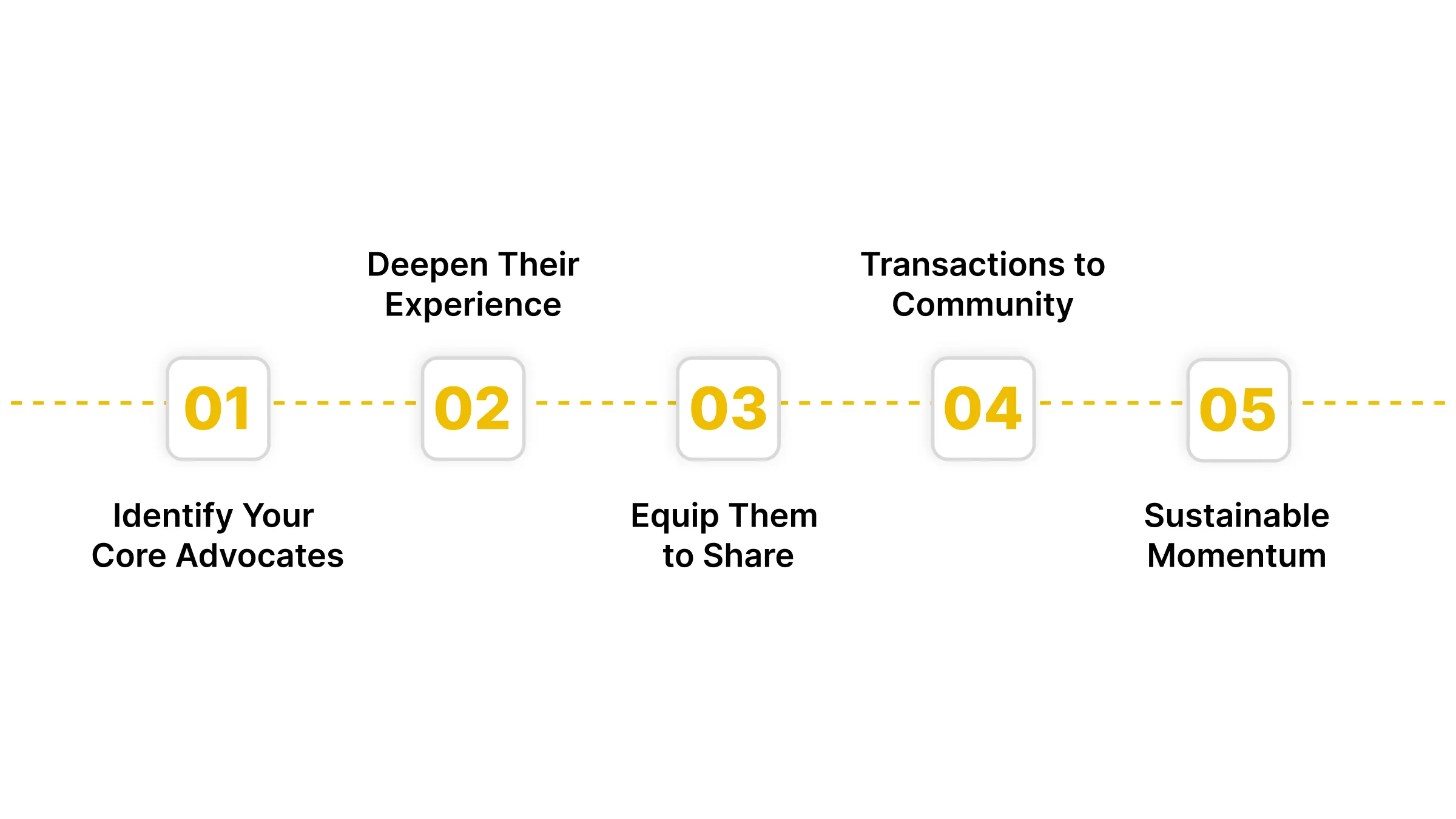
Referral programs work best when they build lasting advocates, not one-time promoters. True advocacy grows from trust, recognition, and belonging.
Step 1: Identify Your Core Advocates
Identify customers who are already demonstrating strong engagement. Look at:
- Repeat purchases (loyal buyers signal trust)
- Net Promoter Score (NPS) (happy customers refer more)
- Community activity (forum posts, social engagement, feedback)
These are your future ambassadors. Treat them as partners, not just participants.
Step 2: Deepen Their Experience
Give loyal customers a reason to stay invested. Build ambassador programs that feel exclusive and rewarding:
- Early access to new features or launches.
- Invitations to private events or roundtables.
- Co-marketing opportunities, like case studies or testimonials.
- Beta testing slots for upcoming releases.
Small gestures of trust can turn regular customers into active brand promoters.
Step 3: Equip Them to Share
Make it effortless for advocates to spread the word.
Provide a referral toolkit that includes:
- Branded visuals or short videos
- Ready-to-use social captions
- WhatsApp and email share links
The goal is simple: remove friction. The easier it is to refer, the more often they’ll do it.
Step 4: Shift from Transactions to Community
Referrals should not feel like a one-time exchange. Build a system that celebrates belonging, not just bonuses.
When customers feel like they are part of something bigger, they share naturally. They don’t need reminders because they already believe in what you offer.
High-trust advocates create high-quality referrals. Each recommendation carries credibility that paid campaigns can’t buy.
Step 5: Create Sustainable Momentum
To keep your referral flywheel spinning:
- Align incentives with both business goals and customer motivation
- Add milestones that celebrate small wins
- Example: a five-referral bonus as the first achievement marker
This milestone gives people a clear goal and a sense of progress. Over time, it becomes the backbone of your entire referral ecosystem.
These six strategies turn simple referral programs into powerful, scalable engines for customer acquisition, engagement, and long-term brand loyalty.
However, strategy alone isn’t enough. The actual implementation, timing, and setup determine whether your referral program actually performs.
Also Read: Building a Simple Referral Program in 2025
Implementation Playbook: How to Structure and Launch Your Program
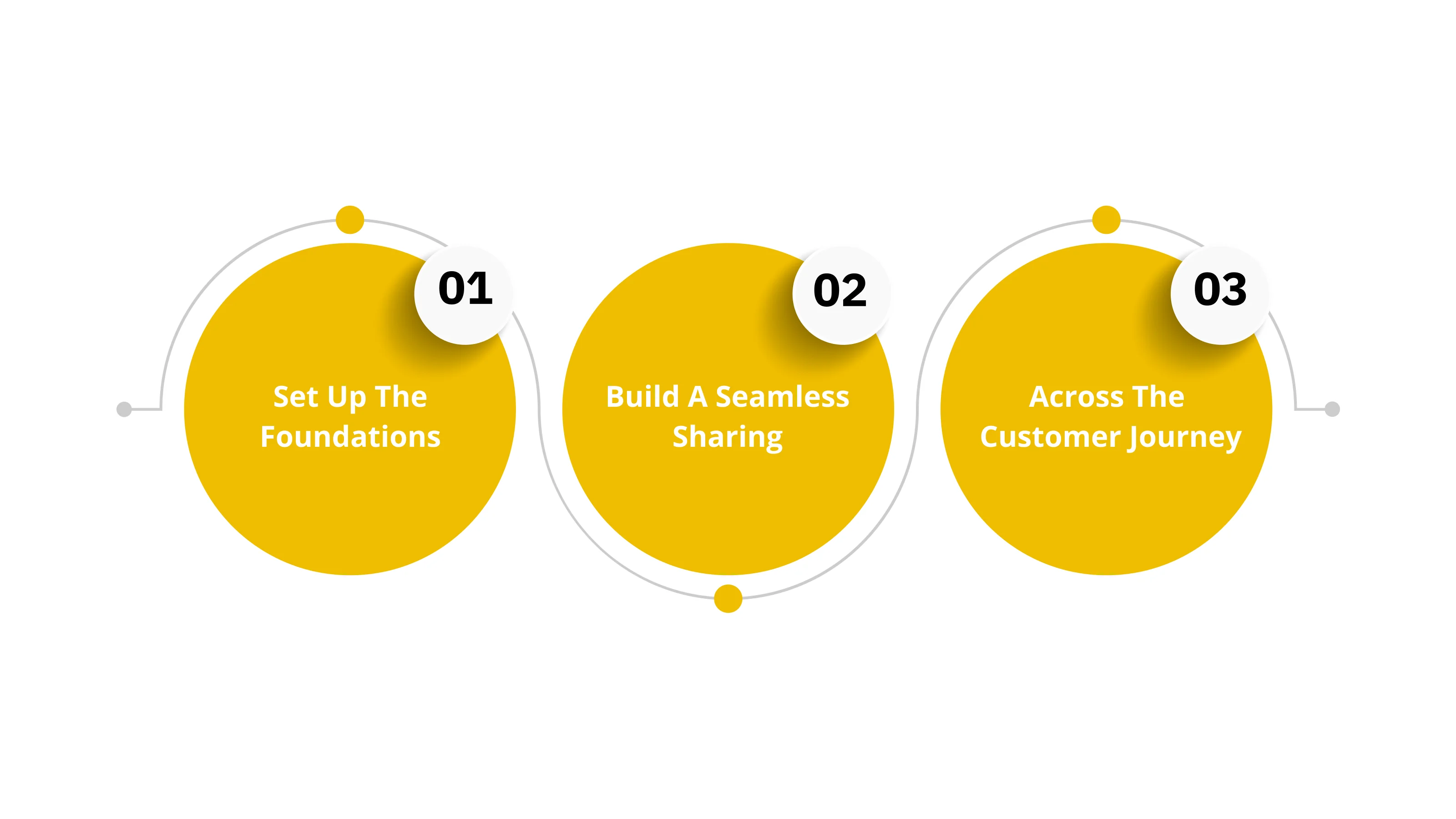
Referral programs drive sustainable growth when they are structured with clarity and launched with precision. This playbook provides a step-by-step execution framework to help you take your incentive strategies from concept to performance.
A. Set Up the Foundations
Every strong referral program begins with a solid foundation. Before designing visuals or rewards, define your objectives and ensure that the structure supports both short-term success and long-term scalability.
1. Define Clear Goals
Decide what you want your program to achieve. The goal determines everything else: incentive type, messaging, and metrics.
Common objectives include:
- New signups or leads for SaaS and marketplace businesses
- First purchases for eCommerce or D2C brands
- Repeat orders and retention for subscription-based models
Once the goal is clear, identify measurable indicators such as participation rate, referral-to-purchase conversion, and cost per acquisition (CPA).
2. Choose the Right Referral Model
Different businesses thrive on different structures. Choose a model that aligns with your audience and sales cycle.
- Two-sided programs promote fairness and trust through shared rewards.
- Tiered programs sustain engagement with progressive milestones.
- Gamified programs add energy with badges, progress tracking, or contests.
Most brands achieve success by combining two-sided fairness with the long-term appeal of tiered rewards.
3. Price Rewards Using Unit Economics
Your rewards should inspire participation without hurting margins. Start with simple math:
- Identify your average order value (AOV).
- Calculate gross margin percentage.
- Estimate the expected referral conversion rate.
Use these figures to keep your cost per acquisition below your paid ad benchmark. Set caps for high-volume referrers to manage total payout. Remember to factor in breakage, the small percentage of unclaimed rewards, which often balances overall cost.
4. Draft Transparent Terms and Conditions
Rules make programs fair and sustainable. Keep them short, readable, and upfront. Include:
- Eligibility (existing customers, account holders, etc.)
- Reward triggers (completed purchase, subscription, or signup)
- Time window (how long referrals remain valid)
- Exclusions (no self-referrals, fake accounts, or bulk submissions)
Transparency protects both your margins and your credibility.
B. Build a Seamless Sharing and Redemption Experience
A great referral program feels effortless to use. Participants should be able to share easily, see progress instantly, and redeem rewards without delay.
1. Offer Multiple Share Options
Different users prefer different channels. Expand your reach with flexible sharing tools:
- Email invites directly from user dashboards
- Social media sharing buttons for quick posts
- WhatsApp or SMS links for personal recommendations
- QR codes on packaging or receipts
- In-app referral features for mobile-first customers
The more accessible the process, the higher your participation rate.
2. Reduce Friction in Redemption
Instant gratification drives repeat engagement. Design the experience so rewards appear automatically, without manual validation.
Use tools that:
- Auto-apply discounts or credits at checkout
- Send instant confirmations when referrals complete
- Display earned rewards directly in the account dashboard
Friction kills motivation. Automation keeps customers coming back.
3. Maintain Transparency Through Live Tracking
Visibility keeps trust high. A live referral dashboard lets customers monitor:
- Referrals sent and completed
- Rewards earned and pending
- Progress toward milestones
Add progress bars, badges, and status updates to maintain momentum. When people see how close they are to the next reward, they are more likely to share again.
4. Implement Fraud Prevention
Protect your program from manipulation. Use:
- Unique referral links tied to customer accounts
- IP and device verification to detect duplicate activity
- Purchase validation before issuing rewards
Fraud prevention protects your ROI and maintains fairness for genuine participants.
Practical Insight: A seamless experience feels invisible. The less a customer has to think about mechanics, the more they’ll focus on sharing.
C. Promote Across the Customer Journey
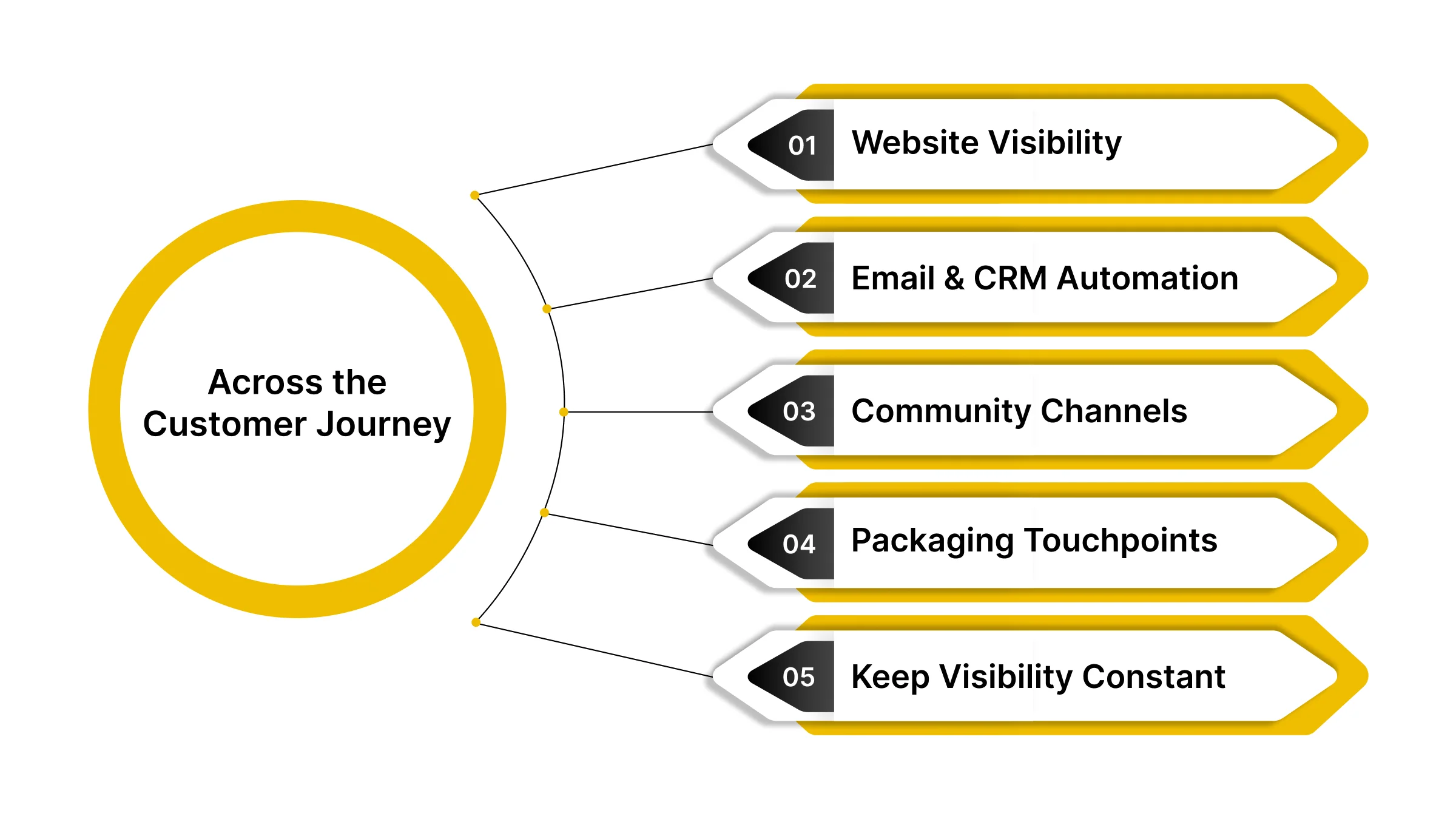
Even the most thoughtful referral program fails without visibility. Customers should encounter referral opportunities at multiple touchpoints throughout their relationship with your brand.
1. Website Visibility
Make your referral program easy to find. Add prompts in:
- Homepage banners and hero sections
- Product pages with small “Refer & Earn” callouts
- Checkout confirmation screens
- Persistent buttons in headers or footers
Use short, benefit-driven language like “Invite friends, earn rewards, and grow together.”
2. Email and CRM Automation
Emails remain one of the most effective referral channels. Integrate the program naturally into lifecycle communication:
- Thank-you emails after a purchase with a referral invite
- Milestone reminders when customers near a reward tier
- Reactivation campaigns for inactive users
- Win-back emails offering referral rewards instead of discounts
Personalize messaging based on customer history for stronger response rates.
3. Social and Community Channels
Turn referrals into a shared experience.
Ideas to try:
- Run UGC contests around referral achievements
- Feature top referrers on your brand’s social channels
- Encourage community-driven posts with dedicated hashtags
- Collaborate with micro-influencers to expand reach
Public recognition inspires participation and builds social credibility.
4. Offline and Packaging Touchpoints
Offline reminders reinforce online actions. Add referral prompts where customers least expect but often notice:
- Inserts inside packages with QR codes
- Stickers or cards on receipts
- Displays in physical stores
Consistency between online and offline messaging keeps referrals top of mind.
5. Keep Visibility Constant
Referral programs should be integrated into the customer experience, not treated as a separate campaign. Maintain steady awareness by:
- Featuring referrals in newsletters and announcements
- Refreshing creative visuals each quarter
- Keeping referral buttons in loyalty dashboards
- Highlighting success stories and user testimonials
Visibility fuels momentum. The more customers encounter your program, the more likely they are to take action.
Simplicity is key. Nector’s intuitive dashboard makes managing your referral program effortless. Book a demo to see how it works and start scaling with confidence.
Once your program is running, tracking results and making small improvements help turn every effort into steady, reliable growth.

Tracking, Optimization, and Scaling What Works
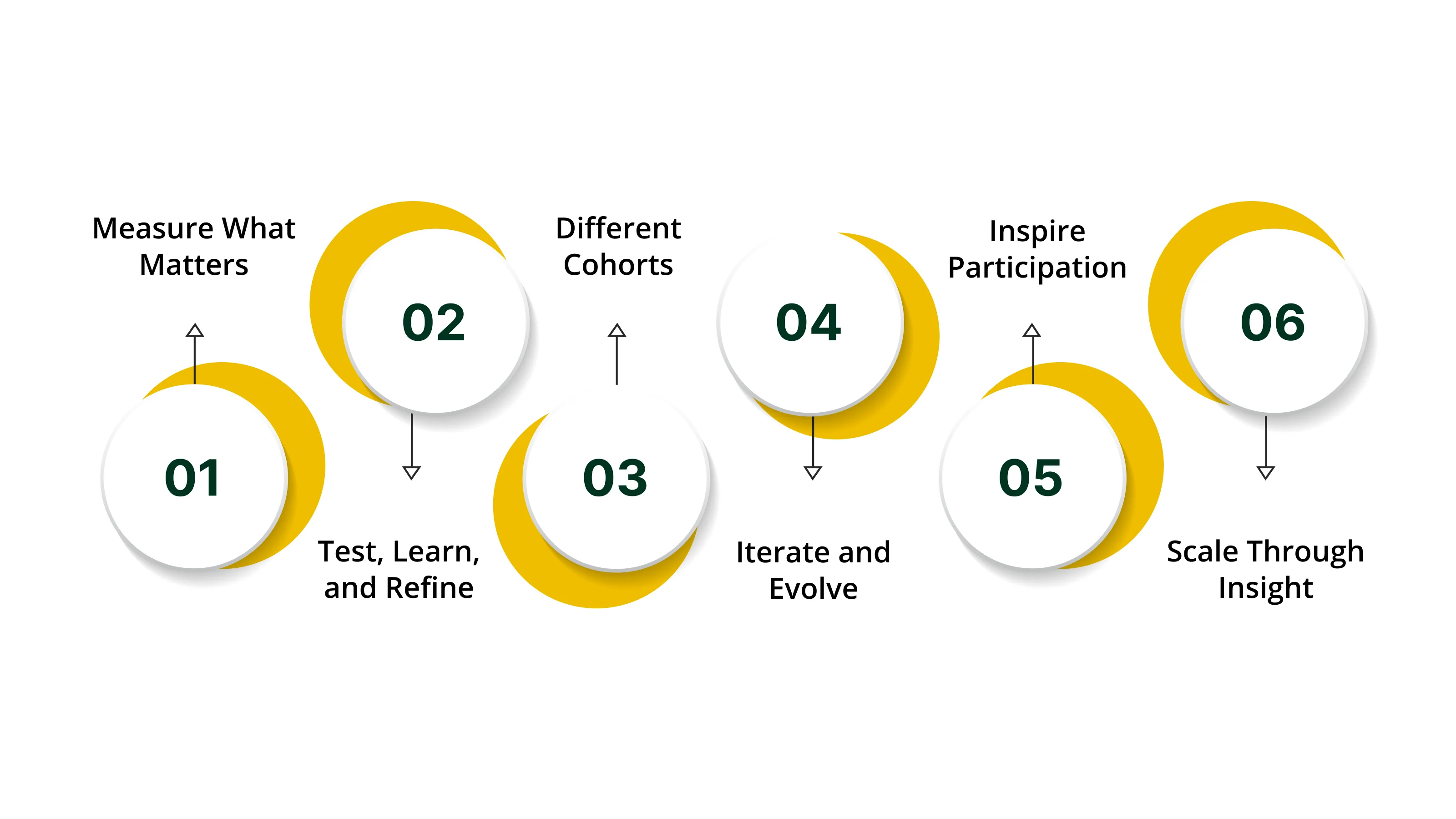
Launching a referral program is only half the journey. Real success comes from tracking results, learning from data, and improving over time. A strong referral system evolves through continuous measurement and iteration.
1. Measure What Matters
Tracking the proper metrics shows how well your program attracts, converts, and retains customers. Focus on data that reflects real business impact, not vanity numbers.
The core KPIs that you should be constantly monitoring, are:
- Participation Rate: The percentage of customers who share their referral link. If this number is low, review your incentive strength or visibility.
- Referral-to-Join Conversion Rate: The share of invited friends who sign up or create an account. This indicates how compelling your offer and messaging are.
- Join-to-Purchase Conversion Rate: The number of referred users who make a purchase. It reveals how closely your referral audience matches your ideal buyer.
- Customer Acquisition Cost (CAC) Reduction: Compare referral-driven CAC with your paid channels. Effective programs should lower acquisition costs while maintaining quality leads.
- Lifetime Value (LTV) Uplift: Measure the long-term value of referred customers. Referred users typically exhibit higher retention rates and increased spending over time.
- Milestone Completions: Track how many participants reach each reward tier. Pay special attention to the five-referral milestone, as it signals sustained motivation.
- Fraud or Abuse Rate: Monitor suspicious activity, such as duplicate accounts or self-referrals. Keeping this rate low maintains program credibility and fairness.
Together, these indicators show whether your referral program is healthy, scalable, and delivering profitable growth.
2. Test, Learn, and Refine
No referral program succeeds on its first try. Consistent testing helps reveal what truly motivates participation and where adjustments are needed.
A/B Testing Ideas
Test one variable at a time to pinpoint what works best. Useful experiments include:
- Incentive Type: Compare discounts, free gifts, or upgrades to identify which drives the highest referral volume.
- Friend Offer Clarity: Test simple versus detailed language, such as “Give $10, Get $10” against “Invite friends and earn rewards.” Precise phrasing often wins.
- Scarcity Mechanics: Experiment with short-term double rewards or limited slots to measure the impact of urgency.
Track results weekly. Even small percentage gains in participation or conversion can compound into significant long-term results.
3. Learn from Different Cohorts
Not every referrer behaves the same way. Segment your participants to understand their motivations and tailor engagement accordingly.
- Top Advocates: These customers refer often and reach milestones quickly. Learn what drives them, whether it is product satisfaction, recognition, or exclusive perks.
- Casual Referrers: They participate occasionally but may need reminders or fresh incentives to stay engaged.
Compare the two groups. Offer ambassadors exclusive recognition or higher-tier rewards, while giving casual users easy wins and milestone nudges.
4. Iterate and Evolve
Optimization is an ongoing process. Maintain a regular rhythm of improvements to keep your program fresh and relevant.
- Conduct monthly micro-tests on messaging, visuals, or incentive timing.
- Perform a quarterly review to assess structure, update creative assets, and refine tiers.
- Refresh your dashboard visuals and communications to maintain engagement.
These small, frequent updates prevent stagnation and align your program with changing customer behavior.
5. Tell Stories That Inspire Participation
Data drives strategy, but stories drive emotion. Use storytelling to strengthen your referral culture and celebrate success.
Feature your best referrers in newsletters, blog posts, or social content. Highlight what they achieved, how they earned rewards, and what they love about your brand.
This simple act has two effects:
- It encourages others to participate by showing real examples of success.
- It normalizes referral activity as part of your brand community.
When people see others like them rewarded and recognized, they feel inspired to join in.
6. Scale Through Insight
Growth comes from doing more of what works. Use your performance data to identify the best-performing incentives, referral messages, and audience segments.
Once you know what consistently delivers results, scale those efforts across channels and campaigns. Refine the details further, but ensure you preserve the elements that make your referral system effective.
Tracking, optimization, and storytelling turn a one-time campaign into a long-term growth engine that runs on trust, data, and continuous improvement. Yet even strong engines can fail if common pitfalls go unchecked.
Common Mistakes That Undermine Referral Programs
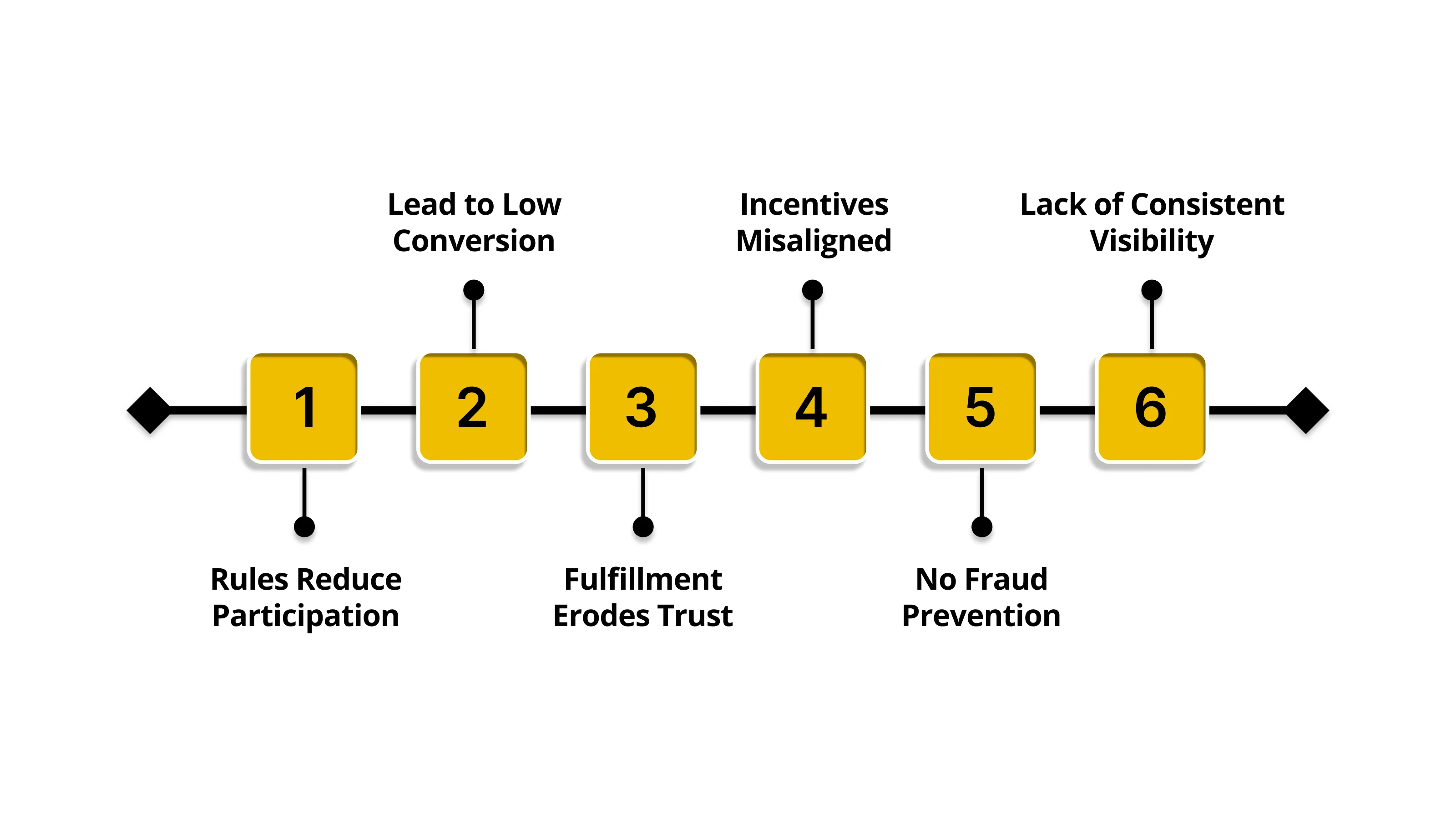
Even well-intentioned referral programs can underperform when small gaps in design or execution go unnoticed. Recognizing and fixing these early prevents wasted effort and protects customer trust.
1. Overcomplicated Rules Reduce Participation
Complex eligibility criteria or unclear steps discourage people from joining. A referral system should be easy to understand in under 10 seconds. Keep the process simple: share, act, earn. The smoother the experience, the higher the participation.
2. Weak Friend Offers Lead to Low Conversion
If the referred friend gets little value, they have no reason to act. Your “friend offer” must be appealing on its own; consider offering instant discounts, bonus credits, or first-purchase perks.
A strong friend incentive boosts conversion rates throughout the entire funnel.
3. Poor Reward Fulfillment Erodes Trust
Delayed or missing rewards damage credibility fast. Automate reward delivery where possible, and always communicate status clearly. When participants see consistency, they’re more likely to refer again.
4. Incentives Misaligned with Margin
Attractive rewards can turn costly if they cut too deeply into profit. Always validate incentive math against unit economics. A program should drive growth sustainably, not at the expense of your bottom line.
5. No Fraud Prevention Invites Abuse
Without checks, programs can be gamed through fake accounts or self-referrals. Utilize link tracking, IP validation, and purchase verification to maintain a clean and fair system.
6. Lack of Consistent Visibility
A great referral program fails if no one sees it. Keep it present across your website, emails, and post-purchase flows. Visibility builds momentum; invisibility kills it.
Small, preventable mistakes often separate strong referral systems from stagnant ones. By addressing these early, brands can preserve trust, profitability, and growth.
Case Studies
These examples demonstrate how brands leverage Nector to foster stronger relationships and achieve measurable results through loyalty and referral programs.
1. Achieving 200x ROI on Loyalty
Your Medicals, a healthcare and wellness brand, wanted to keep customers coming back. They used Nector’s loyalty program to reward purchases, reviews, and referrals, turning everyday actions into reasons to stay connected.
The results were impressive. For every dollar spent, the brand earned over 200 times in return. This proved that a simple, automated rewards system can increase both loyalty and long-term profit.
2. Driving a 204% Increase in Repeat Purchases
XYXX, a direct-to-consumer innerwear brand, set out to build a loyal customer community. They launched a multi-tier Nector rewards program that encouraged repeat purchases and referrals through clear goals and milestone rewards.
Within months, they saw a 204% jump in repeat purchases, demonstrating the significant impact small incentives can have. Customers began sharing their experiences and inviting others to join, helping the brand grow through trust and word of mouth.
These stories show what’s possible when loyalty and referrals work together. Even small teams can achieve strong, lasting growth with Nector’s automated platform.
Build Your Referral System with Nector
Paid ads can help you grow fast, but they rarely build loyalty. Nector’s referral solutions enable you to turn satisfied customers into long-term advocates who bring real, high-quality referrals.
- Lower Customer Acquisition Costs: Reduce ad spend and acquire new customers through referrals that convert up to 3x more effectively. Reward word-of-mouth, not impressions.
- Dual-Sided Rewards: Motivate both referrers and referees with flexible rewards like coins, coupons, or discounts that make every referral feel fair and rewarding.
- Built-in Fraud Protection: Detect fake referrals automatically. Nector tracks IPs, links, and devices to ensure every referral is genuine and every reward is deserved.
- Easy Integration and Tracking: Set up in under 30 minutes. Connect Nector directly to your Shopify or WooCommerce store and track real-time results through your dashboard.
- Seamless Setup and Scalability: Nector integrates with over 50 leading tools: Shopify, Klaviyo, Contlo, Judge.me, WhatsApp, and more, so your referral system fits effortlessly into your marketing stack.
This approach gives your brand a high-impact, low-effort loyalty system that grows with you.
Read more about how Nector can boost your referral programs here.
Start With One Milestone, Scale With Strategy
Referral incentives are among the most potent growth tools for modern brands. When built with intention, they turn loyal customers into advocates who drive engagement and trust. Tiered and two-sided programs work best because they combine motivation with fairness, rewarding both referrer and referee.
If you’re just starting, keep it simple. A two-tier setup with a five-referral milestone bonus creates momentum and keeps customers engaged.
As participation grows, consider adding creative rewards such as early access, upgrades, or charitable gifts to further strengthen the emotional connection.
Your end goal should be to build incentives that make customers proud to advocate for you.
Nector helps you create and grow a referral program that truly delivers results. It handles everything from tracking to rewarding, so you can focus on keeping customers happy.
Create a referral program that delights your customers while providing a reliable support system for your team.
Get started for free with Nector’s Starter Plan, no credit card needed, and watch your referrals turn into steady growth.
FAQ
1. What rewards can I offer in a referral program?
You can offer discounts, store credit, free products, upgrades, or cash rewards. Choose incentives that fit your customer preferences and profit margins.
2. How do I make sure referrals are valid?
Set clear eligibility rules, such as “new customers only.” Verify each referral through purchase or signup tracking, and use fraud checks like link or IP monitoring. A transparent process protects both your brand and your loyal referrers.
3. How can participants track their referral status?
Provide a dashboard that shows pending, completed, and rewarded stages. You can also send automated updates through email or in-app notifications.
4. What if the friend's offer isn’t strong enough?
If the friend incentive lacks appeal, conversion will drop. Strengthen it with a clear value proposition, such as a first-purchase discount or bonus credit.
5. Can referral programs work for B2B as well as B2C?
Yes. In B2B programs, rewards such as service credits or co-marketing opportunities encourage partners and advocates to participate effectively.
6. How many referrals should someone make before earning a big reward?
Milestones like five referrals are effective. They give participants a clear target and encourage ongoing engagement without adding complexity.
7. What are the most common mistakes in referral programs?
Common pitfalls include complicated rules, unclear rewards, slow fulfillment, lack of fraud control, and poor visibility across customer touchpoints. Fixing these early can turn a stagnant program into a reliable source of organic growth.
FAQs
Start Building Customer Retention That Lasts


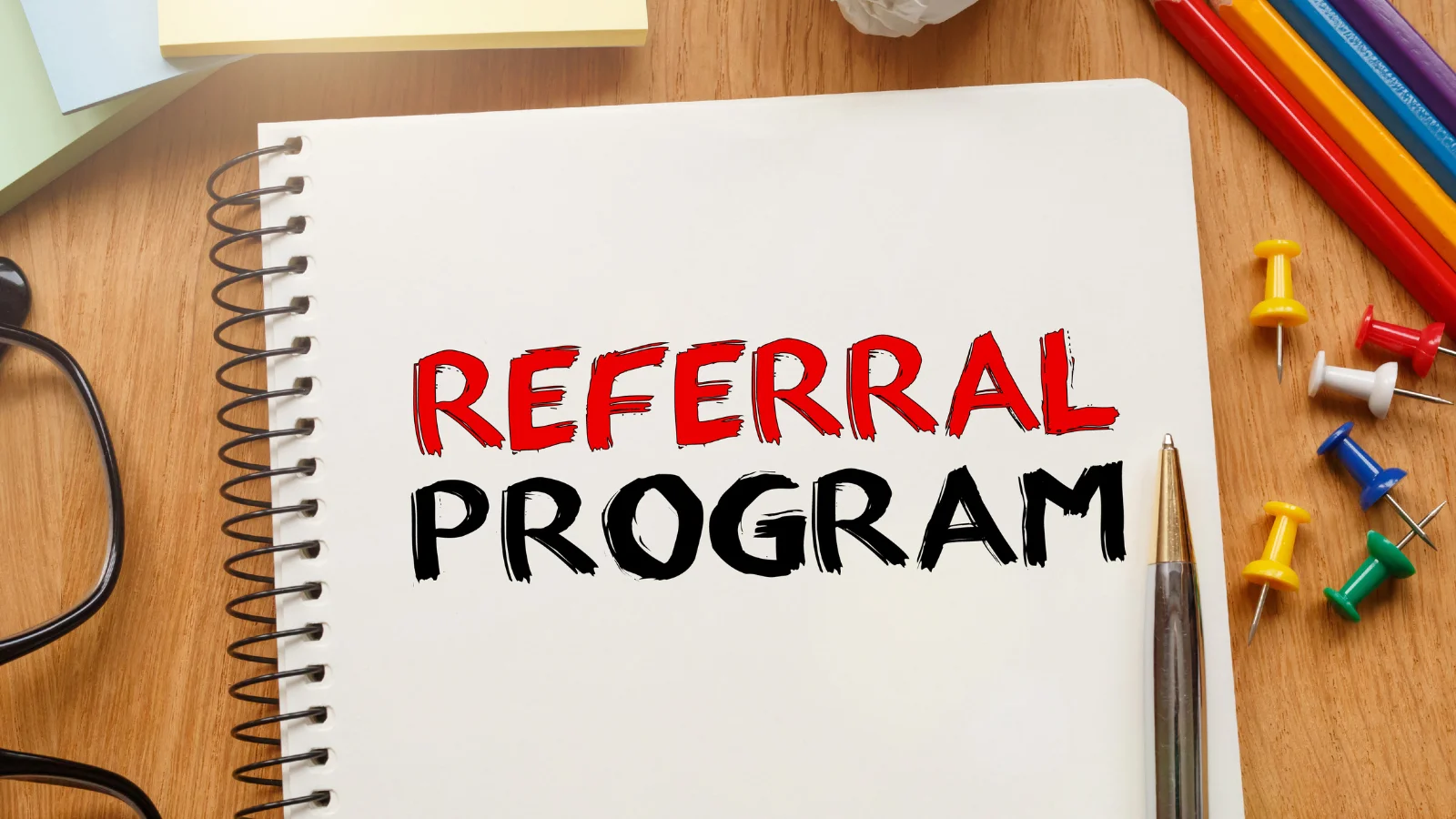

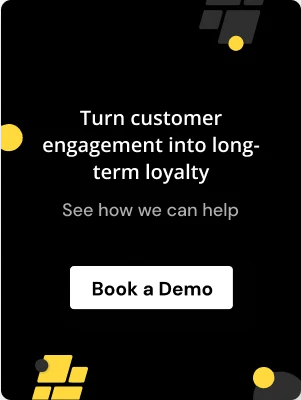
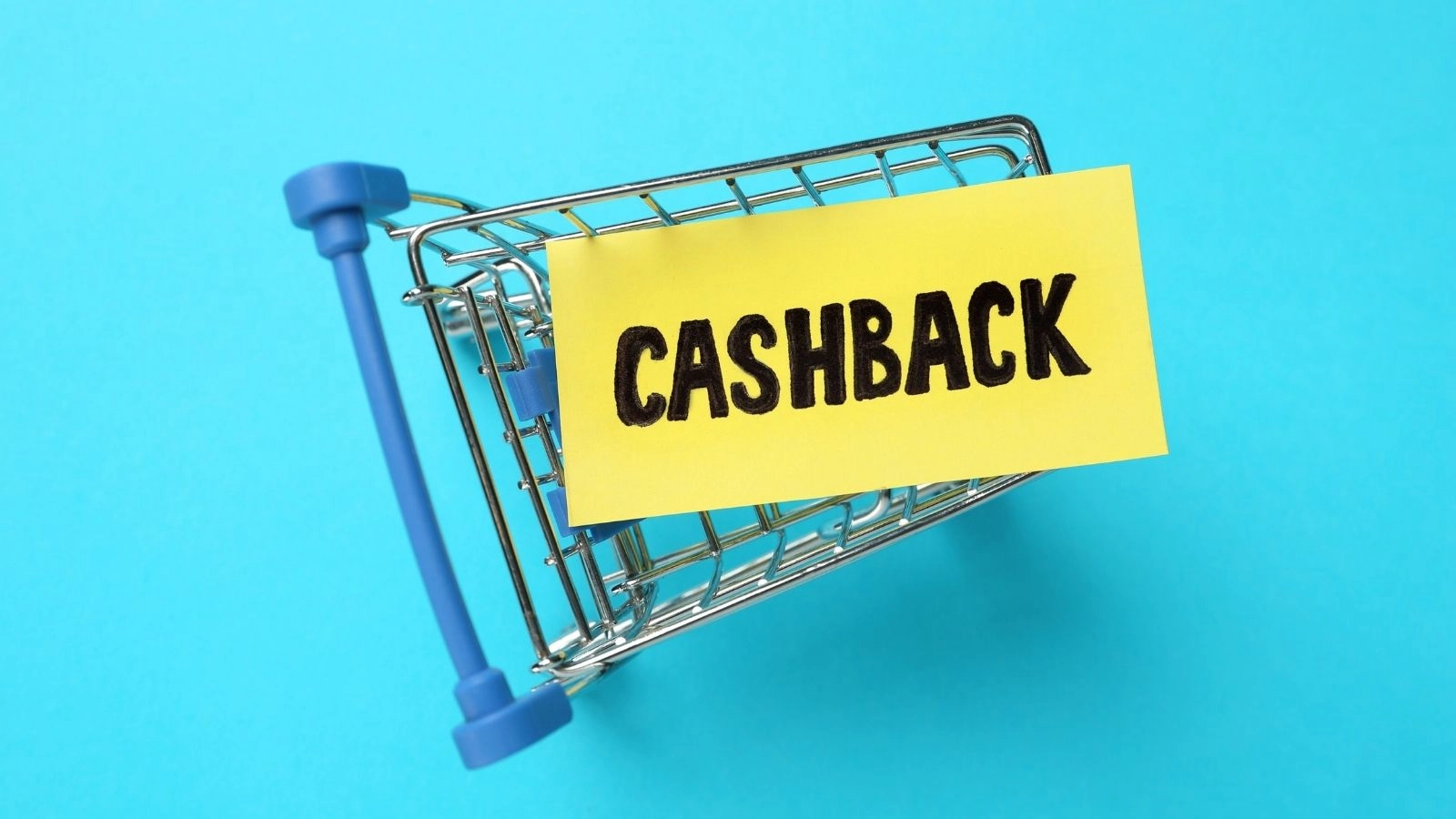
.webp)


